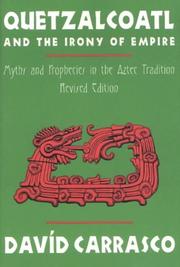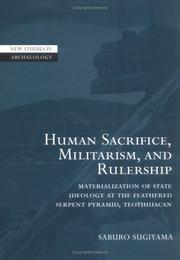| Listing 1 - 5 of 5 |
Sort by
|
Book
ISBN: 9781527537170 152753717X 1527539962 9781527539969 Year: 2019 Publisher: Newcastle upon Tyne, UK
Abstract | Keywords | Export | Availability | Bookmark
 Loading...
Loading...Choose an application
- Reference Manager
- EndNote
- RefWorks (Direct export to RefWorks)
Most American schoolbooks claim that the Aztex ruler Moctezuma II confused the Spanish conquistador Hernán Cortés for the Aztec god Quetzalcoatl, a fabulous, fair-skinned priest king of ancient times who had promised to return, which is why Moctezuma voluntarily surrendered his mighty empire. In the past, the tale of Quetzalcoatl has inspired many people to speculate about pre-Columbian invaders from the Old World. It has also been abused as another presumed proof of white supremacy. Indigenous traditions, however, saw a Mexican Messiah who played an important part in constructing the Mexican national identity. This book demonstrates that the story of the returning god is a product of "fake news" uttered by Cortés. It does so by analysing the most important sources of the Quetzalcoatl-tale. A systematic context-enlargement that also includes ethnographic information and contemporary history reveals why and how Cortés constructed this story, and why and how the Aztec elite adopted it. This method proves to be an epistemological tool which allows researchers to identity pre-Hispanic information in ethnohistorical texts of colonial times. As a result, the true Quetzalcoatl behind the legend comes to light.
Quetzalcoatl --- Cortés, Hernán, --- Cortés, Hernán --- Cortes, Fernando --- Cortez, Fernando --- Ehecatl Quetzalcoatl --- Topiltzin Quetzalcoatl --- Ce Ácatl --- Feathered Serpent --- Plumed Serpent --- Quezacotl --- Kukulcan --- Mexico --- History
Book
ISBN: 145719659X 1607323990 1607323907 9781607323990 9781607323907 Year: 2015 Publisher: Boulder
Abstract | Keywords | Export | Availability | Bookmark
 Loading...
Loading...Choose an application
- Reference Manager
- EndNote
- RefWorks (Direct export to RefWorks)
"The Myth of Quetzalcoatl is a translation of Alfredo López Austin's 1973 book Hombre-Dios: Religión y politica en el mundo náhuatl. Despite its pervasive and lasting influence on the study of Mesoamerican history, religion in general, and the Quetzalcoatl myth in particular, this is the first English translation of the work"--
Aztecs --- Aztec mythology. --- Social life and customs. --- Quetzalcoatl --- Mythology, Aztec --- Ehecatl Quetzalcoatl --- Topiltzin Quetzalcoatl --- Ce Ácatl --- Feathered Serpent --- Plumed Serpent --- Quezacotl --- Kukulcan

ISBN: 1607321327 9781607321323 087081558X 9780870815584 Year: 2000 Publisher: Boulder, Colo. University Press of Colorado
Abstract | Keywords | Export | Availability | Bookmark
 Loading...
Loading...Choose an application
- Reference Manager
- EndNote
- RefWorks (Direct export to RefWorks)
Sacred space --- Aztecs --- Aztec mythology. --- Holy places --- Places, Sacred --- Sacred places --- Sacred sites --- Sacred spaces --- Sites, Sacred --- Space, Sacred --- Holy, The --- Religion and geography --- Urbanization --- Mythology, Aztec --- Urban residence. --- Quetzalcoatl --- Ehecatl Quetzalcoatl --- Topiltzin Quetzalcoatl --- Ce Ácatl --- Feathered Serpent --- Plumed Serpent --- Quezacotl --- Kukulcan --- City dwellers --- Urban residence --- Urban Aztecs.

ISBN: 9780511489563 9780521780568 0511113250 9780511113253 0511489560 128041507X 9781280415074 9786610415076 6610415072 052178056X 0511112742 9780511112744 1107129079 0511299338 0511181604 0511198434 Year: 2005 Publisher: Cambridge, UK ; New York : Cambridge University Press,
Abstract | Keywords | Export | Availability | Bookmark
 Loading...
Loading...Choose an application
- Reference Manager
- EndNote
- RefWorks (Direct export to RefWorks)
Teotihuacan was one of the earliest and more populous preColumbian cities, and the Feathered Serpent was its vital monument, erected circa 200 AD. This work explores the religious meanings and political implications of the pyramid with meticulous and thorough analyses of substantially new excavation data. Challenging the traditional view of the city as a legendary, sacred, or anonymously-governed centre, the book provides significant new insights on the Teotihuacan polity and society. It provides interpretations on the pyramid's location, architecture, sculptures, iconography, mass sacrificial graves and rich symbolic offerings, and concludes that the pyramid commemorated the accession of rulers who were inscribed to govern with military force on behalf of the gods. This archaeological examination of the monument shows it to be the physical manifestation of state ideologies such as the symbolism of human sacrifice, militarism, and individual-centred divine authority, ideologies which were later diffused among other Mesoamerican urban centres.
Indians of Mexico --- Human sacrifice --- Excavations (Archaeology) --- Human remains (Archaeology) --- Bioarchaeology --- Skeletal remains (Archaeology) --- Human skeleton --- Primate remains (Archaeology) --- Archaeological digs --- Archaeological excavations --- Digs (Archaeology) --- Excavation sites (Archaeology) --- Ruins --- Sites, Excavation (Archaeology) --- Archaeology --- Sacrifice, Human --- Sacrifice --- Indians of North America --- Indigenous peoples --- Meso-America --- Meso-American Indians --- Mesoamerica --- Mesoamerican Indians --- Pre-Columbian Indians --- Precolumbian Indians --- Ethnology --- Politics and government. --- Rites and ceremonies. --- Antiquities. --- Quetzalcoatl --- Ehecatl Quetzalcoatl --- Topiltzin Quetzalcoatl --- Ce Ácatl --- Feathered Serpent --- Plumed Serpent --- Quezacotl --- Kukulcan --- Teotihuacán Site (San Juan Teotihuacán, Mexico) --- San Juan Teotihuacán (Mexico) --- Mexico --- Antiquities --- Quetzalcoatl (Aztec deity) --- Ritual murder --- Social Sciences --- Archeology --- Quetzalcoatl (Mesoamerican deity) --- Teotihuacan Site (San Juan Teotihuacan, Mexico) --- San Juan Teotihuacan (Mexico)

Abstract | Keywords | Export | Availability | Bookmark
 Loading...
Loading...Choose an application
- Reference Manager
- EndNote
- RefWorks (Direct export to RefWorks)
Ce Ácatl (Aztec deity) --- Ehecatl Quetzalcoatl (Aztec deity) --- Quetzalcoatl (Aztec deity) --- Quetzalcoatl (Azteekse godheid) --- Quetzalcóatl (Divinité aztèque) --- Topiltzin Quetzalcoatl (Aztec deity) --- Indians of Mexico --- Human sacrifice --- Excavations (Archaeology) --- Human remains (Archaeology) --- Quetzalcoatl (Divinité aztèque) --- Indiens d'Amérique --- Sacrifice humain --- Fouilles (Archéologie) --- Restes humains (Archéologie) --- Politics and government. --- Rites and ceremonies --- Antiquities. --- Politique et gouvernement --- Rites et cérémonies --- Antiquités --- Teotihuacãn Site (San Juan Teotihuacãn, Mexico) --- San Juan Teotihuacãn (Mexico) --- Teotihuacãn (Mexique : Site archéologique) --- San Juan Teotihuacãn (Mexique) --- Quetzalcoatl (Divinité aztèque) --- Indiens d'Amérique --- Fouilles (Archéologie) --- Restes humains (Archéologie) --- Rites et cérémonies --- Antiquités --- Teotihuacán Site (San Juan Teotihuacán, Mexico) --- San Juan Teotihuacán (Mexico) --- Teotihuacán (Mexique : Site archéologique) --- San Juan Teotihuacán (Mexique) --- Mexico --- San Juan Teotihuacán (Mexico) --- Politics and government --- Antiquities --- Teotihuacán Site (San Juan Teotihuacán, Mexico) --- Quetzalcoatl
| Listing 1 - 5 of 5 |
Sort by
|

 Search
Search Feedback
Feedback About UniCat
About UniCat  Help
Help News
News